| City/Town: • Montgomery |
| Location Class: • Commercial |
| Built: • 1888 | Abandoned: • 1906 |
| Status: • Demolished |
| Photojournalist: • David Bulit |
Table of Contents
Court Square
If you’ve ever been to Court Square in Montgomery, you’ve likely seen the large cast-iron fountain which dominates the roundabout. The historical buildings around the fountain, which was known as the “romantic center” of the city, have mostly been demolished, with one entire block of them in the 1960s to make way for a Pizitz department store that opened in 1972. Before Pizitz, the block consisted of the Electrik Maid Bakery, Elebash Jewelry Company, Tangerine Cafeteria, Stanley Paulger photography, Campbell Shoe Company, Bon Marche, Lee’s, J. C. Penney, and Stein’s.
To the north was the old Exchange Hotel where according to Heart of the Confederacy (1937), “William L. Yancey, stirring secessionist orator, introduced Jeff Davis to cheering crowds with the immortal words: “The man and the hour have met.” From this building flashed the message which precipitated the first engagement in the War Between the States, the bombardment of Fort Sumter.” The hotel was demolished sometime in the 1960s to make way for the current Colonial Bank building. On the opposite corner, one can find the former First National Building, although much different than when it was first built. Before that, the corner was occupied by a handsome Victorian skyscraper known as the Moses Building.
Moses Brothers
Alfred Huger Moses was born to a Jewish family on September 16, 1840, in Charleston, South Carolina, the son of Adeline Lyon and Levy Isaiah Moses. In 1860, Alfred graduated from the College of Charleston before moving to Montgomery where he apprenticed in a local law office. During the Civil War, he served as the clerk of the Confederate District Court in Montgomery and was a member of the Alabama Rebels, a civil defense volunteer militia company. He was soon joined by his brothers Henry Clay and Mordecai Lyons Moses who also served in the Confederate Army.
Following the war, the three brothers founded an insurance and real business under the name Moses Brothers Banking & Realty Company and invested in the city’s heavily depressed real estate market. With a loan of $8,000, the brothers bought stores along Commerce and South Court Streets for as low as $2,500, a fraction of their worth just a few years earlier.
In 1875, Mordecai was elected the first Democratic mayor of Montgomery after the war and later as president of the Montgomery Gas and Electric Light Company. He lived at 530 South Perry Street known today as the “House of the Mayors.” Alfred Moses lived in the house later occupied by Archibald Lowndes “Archie” Tyson, now known as Tyson Manor. Henry Clay Moses lived in the former home of Judge J. Q. Smith which was demolished in the 1920s to make for the construction of Sidney Lanier High School.
Their siblings Joseph Winthrop, Judah Touro, Sarah L., Rosanna Cecilia, Emily, and Grace Moses joined them in Montgomery along with their parents. The eldest son, Joseph, was an attorney and was a partner of Colonel John W. A. Sanford. At the time of his death in 1876, he was at the head of the Montgomery public schools system.
Sheffield, Alabama
In 1880, coal and iron ore were found in North Alabama, and Alfred Moses and his brothers invested in some mines near Florence, Alabama. They purchased 30,000 acres across the Tennessee River and incorporated a new city named Sheffield, Alabama after the steel-producing city of Sheffield, England. Moses served as the town’s first mayor. He secured investors to fund the building of a blast furnace, as well as railroad links between Birmingham, Mobile, and Chicago, and sold stock to his investors via his Sheffield Land, Iron, and Coal Company.
In early 1884, Moses sold 75 acres in the proposed town for $350,000, a profit of more than a quarter of a million dollars over the purchase price of the land. Soon after the sale though, the Marine National and the brokerage firm Grant and Ward of New York collapsed which had a rippling effect across Wall Street, causing other firms to fail. Two of these firms were financing the rail link to Sheffield. Construction on the line stopped; panicked owners dumped their newly acquired land in Sheffield and the iron foundry investor backed out. Property in Sheffield became worthless and the brothers’ business venture was deemed a failure by many.
Despite the loss of the town’s investments, Moses persisted, and by the end of 1884, he had begun building houses and grading streets. Railroad construction resumed the following year and by 1886, the first blast furnace was operating. In 1887, the Alabama and Tennessee Iron and Coal Company chose Sheffield as its headquarters and built three new blast furnaces.
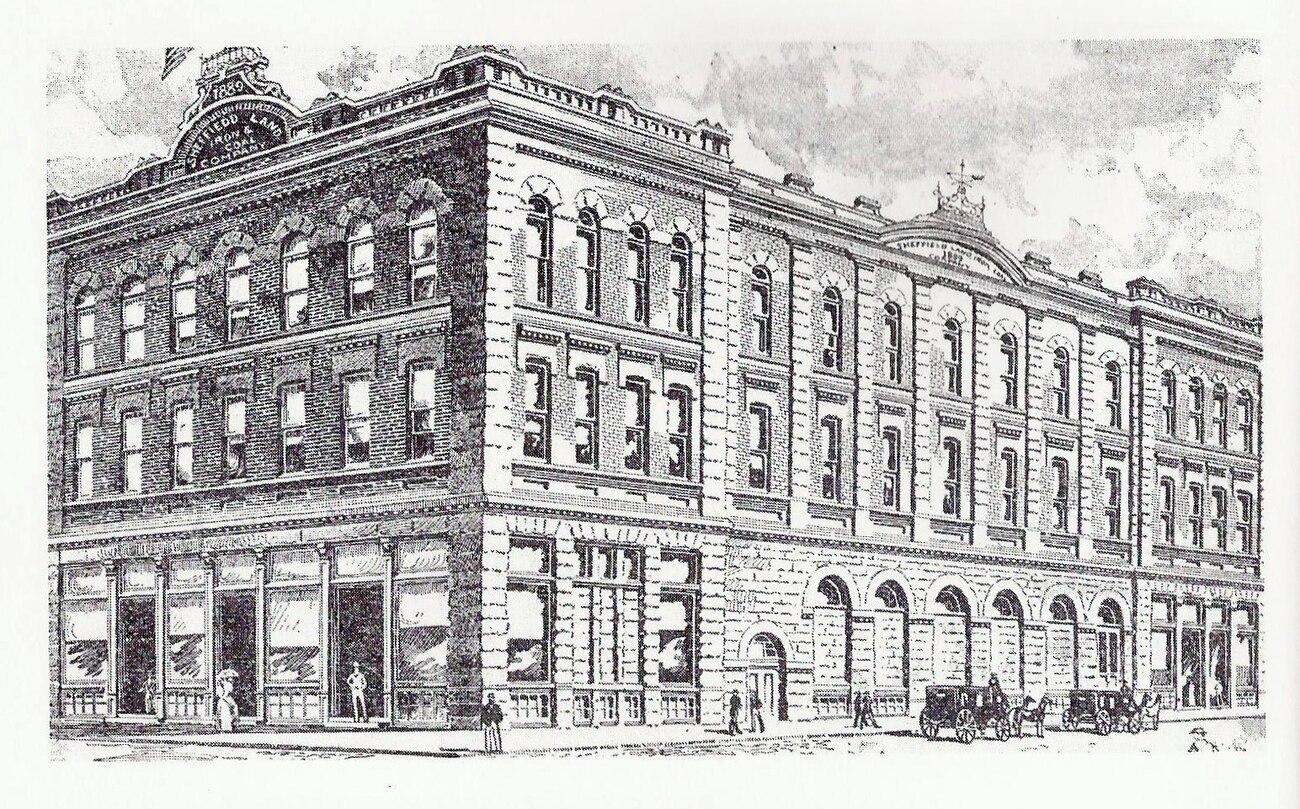
Moses Building
In 1888, Montgomery’s largest business was the Moses Brothers Banking & Realty Company, and they built the city’s first “skyscraper,” a six-story Victorian-style building on Court Square across from the Exchange Hotel. The Montgomery Advertiser described the building as one of the “handsomest banking offices in the South.” The exterior had counters and pilasters made of hand-carved and highly polished oak. The whole was surmounted with artistically complex grillwork made of brass.
The interior was “arranged expressly for the wants and convenience of the firms occupying the offices. The cupboards, bookcases, cabinets, etc., are finished in hardwood, oak, and in the same elegant manner as the work on the outside. These are dust and rat-proof. The brass work is polished from the surface and is of the finest quality made. the combination of brass and beveled-edge French plate glass makes a most elegant and handsome finish. The wickets are of artistic design prepared especially for Moses Brothers. The counters and partitions rest on a marble base, and the counter ledge is also of marble, very handsomely carved and finished.
The opening for the paying and receiving tellers are supplied with marble slabs covering the entire space over which they work. In point of fine workmanship, style, and finish the fixtures are the finest by long odds in this state. The outfit was designed especially for Moses Brothers and manufactured by the Terry Manufacturing Company, Nashville, Tenn. The work was done under the personal direction of Mr. P. B. Clarke. The office furniture was supplied by Mr. B. Wolff, rugs, and etc., by the Polak Company and Goetter, Weil & Co.” The bank vault was put in by the Montgomery Iron Works.
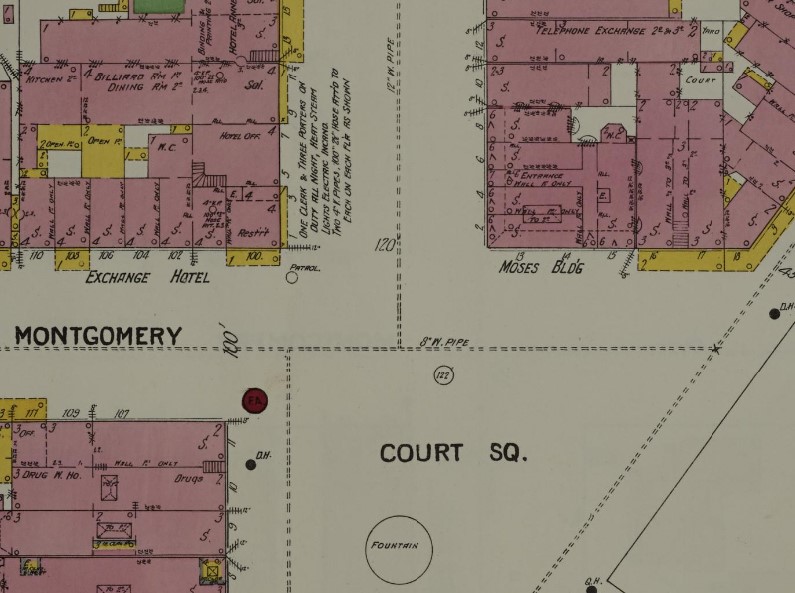
Loss, Bankruptcy, and Failure
In 1891, the Moses brothers’ business venture in Sheffield and the Moses Brothers Banking & Realty Company failed after the price of pig iron plummeted below $12 per ton, less than the cost for Sheffield’s foundries to produce and deliver it, and the local supply of iron was found to be inflated causing the railroads to pull out from completing the links from Sheffield to the rail network. After the Panic of 1893, the blast furnaces were closed and most of Sheffield’s residents departed. The brothers lost everything including $500,000 worth of real estate in Montgomery which was auctioned off for a fraction of their actual value.
Sheffield’s blast furnaces were restarted in 1901 but closed once again in 1907. Eventually, U.S. Steel bought the furnaces but permanently closed them just prior to the Great Depression of 1929. Today, Sheffield is a small industrial city that no longer produces iron or steel. After the Moses brothers lost their fortunes, Alfred and Mordecai moved their families to Saint Louis, Missouri, and their brother Henry Clay Moses moved to New York City. In the end, they all returned to Montgomery after their deaths and were interred in Oakwood Cemetery.
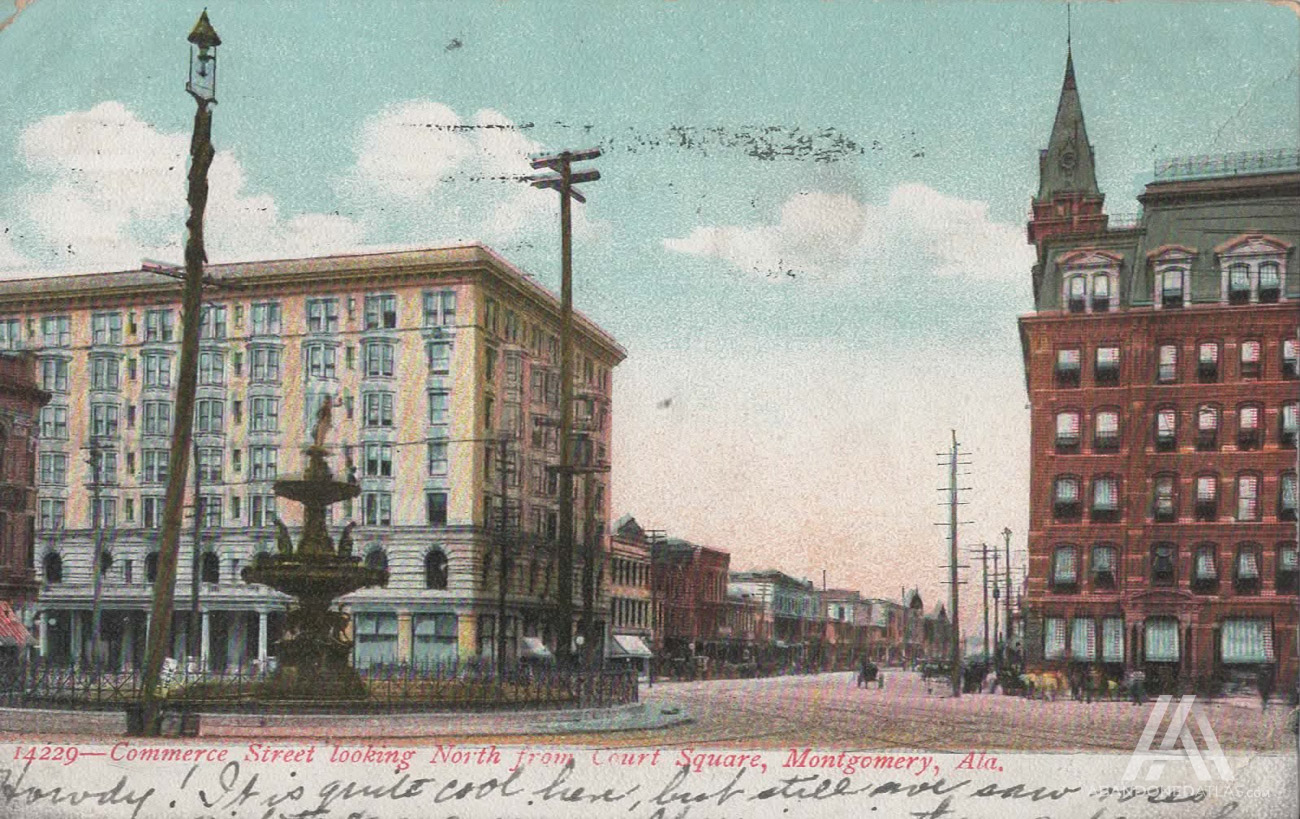
The Moses Building was purchased by Mr. Wright of Dunkirk, New York in a forced sale. In April 1905, William Franklin Vandiver purchased the building from Wright’s estate for approximately $130,000, regarded at the time as a remarkably low price for the property. Vandiver made initial plans to raise the building from a six-story building to eight or ten stories, but after architects determined that wasn’t feasible, he made other plans.
In June 1906, a transaction was made between W. F. Vandiver and the First National Bank of Montgomery in which Vandiver received a newly constructed skyscraper located just up the street and the First National Bank received the Moses Building in exchange. The executives of the bank quickly made plans to renovate the ground floor of the Moses Building for their use which would include 6,300- feet of floor space with entrances on Commerce Street and Court Square.
Shortly after the exchange, leases were secured and the building was occupied from top to bottom. It was regarded as one of the most desirable office buildings in the city. The building required lots of maintenance and the leases were deemed too expensive for most tenants. By October 1906, the Moses Building was vacant.
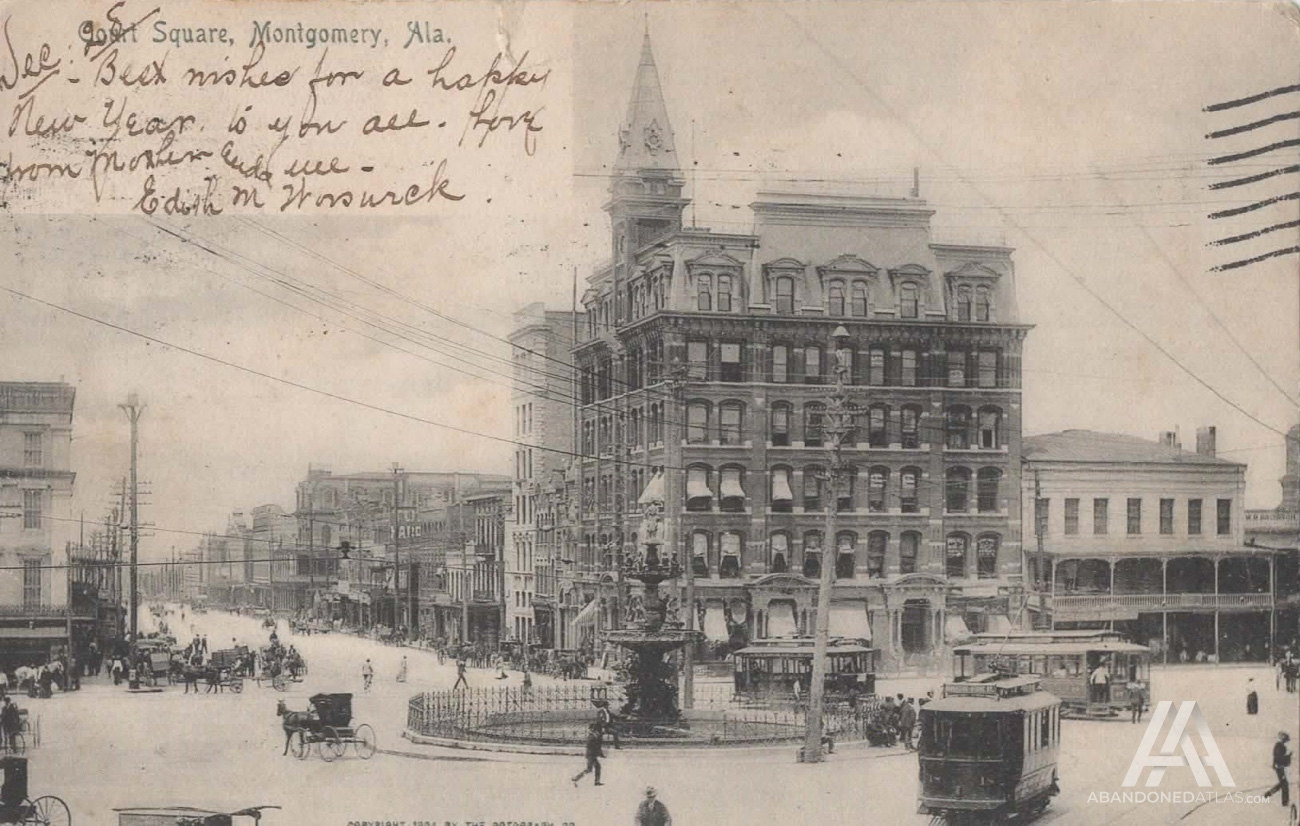
First National Bank Building
In December 1906, it was announced that the Moses Building would be razed for a modern twelve-story skyscraper at a cost of $300,000. The contractors in charge of construction were the Wells Brothers Company of New York, J. E. R. Carpenter, representing the architects, and Walter J. Smith, representing the contracting firm. The building was designed by Carpenter, Blair & Gould of New York in what was described in the Modern Renaissance style.
The building was constructed of steel and concrete with the exterior being of stone, brick, and terra cotta adorned with ornamental iron trimmings. The architect claimed that it would “probably be the finest banking office in the South.” The building was also equipped with electric elevators and phones in every office, modern improvements that were rarely seen in the South. The demolition of the Moses Building occurred in 1907.
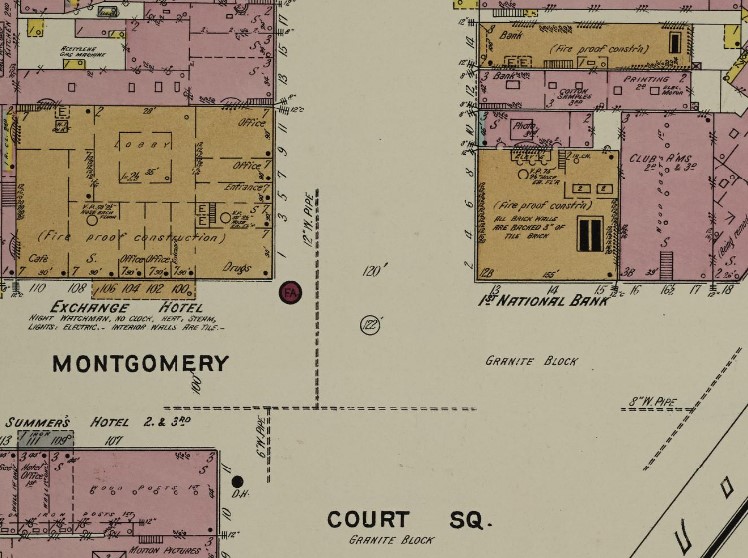
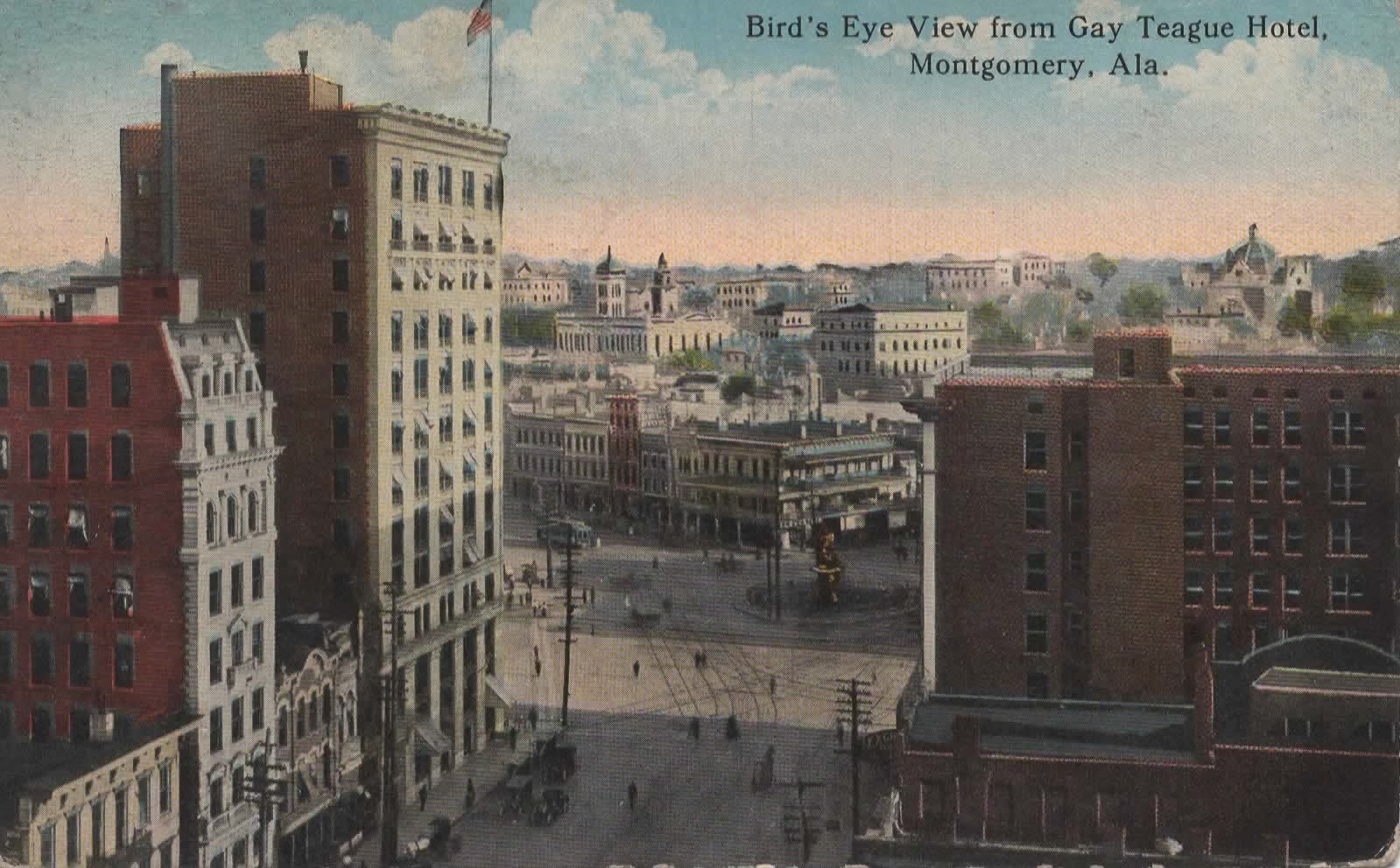
Decorative Lion Heads
The bank was renamed First Alabama Bank of Montgomery in 1975. As part of this new era, the First National Bank building was renovated in 1978. All of its ornamentations were stripped off, the double-hung windows were replaced with a window wall, and signage now surrounds the entire top floor. It is completely unrecognizable from its original design. This renovation occurred during the city’s “urban renewal” era when Court Square was closed and the fountain was situated in a brick-paved plaza. A few of the decorative lion heads which surrounded the building though were saved and installed in Court Square. A plaque under the installment reads:
“Decorative Lions Heads
1907 – 1978
Presented to Montgomery by the First Alabama Bank of Montgomery, N. A.
These decorative terra cotta lions heads, typical of the ornamentation used in commercial style architecture in the early par of the 20th Century, were utilized by the First National Bank of Montgomery on the cornice of their 12 story building from 1907 to 1978. Organized on April 18, 1871, the first location of the bank was on Dexter Avenue which was then called Market Street. In 1975, the name of the bank was changed to First Alabama Bank of Montgomery, N.A. Extensive renovations to the 12 story building in 1978, including the removal of the lions heads, created a new look for First Alabama and the downtown Montgomery area.”
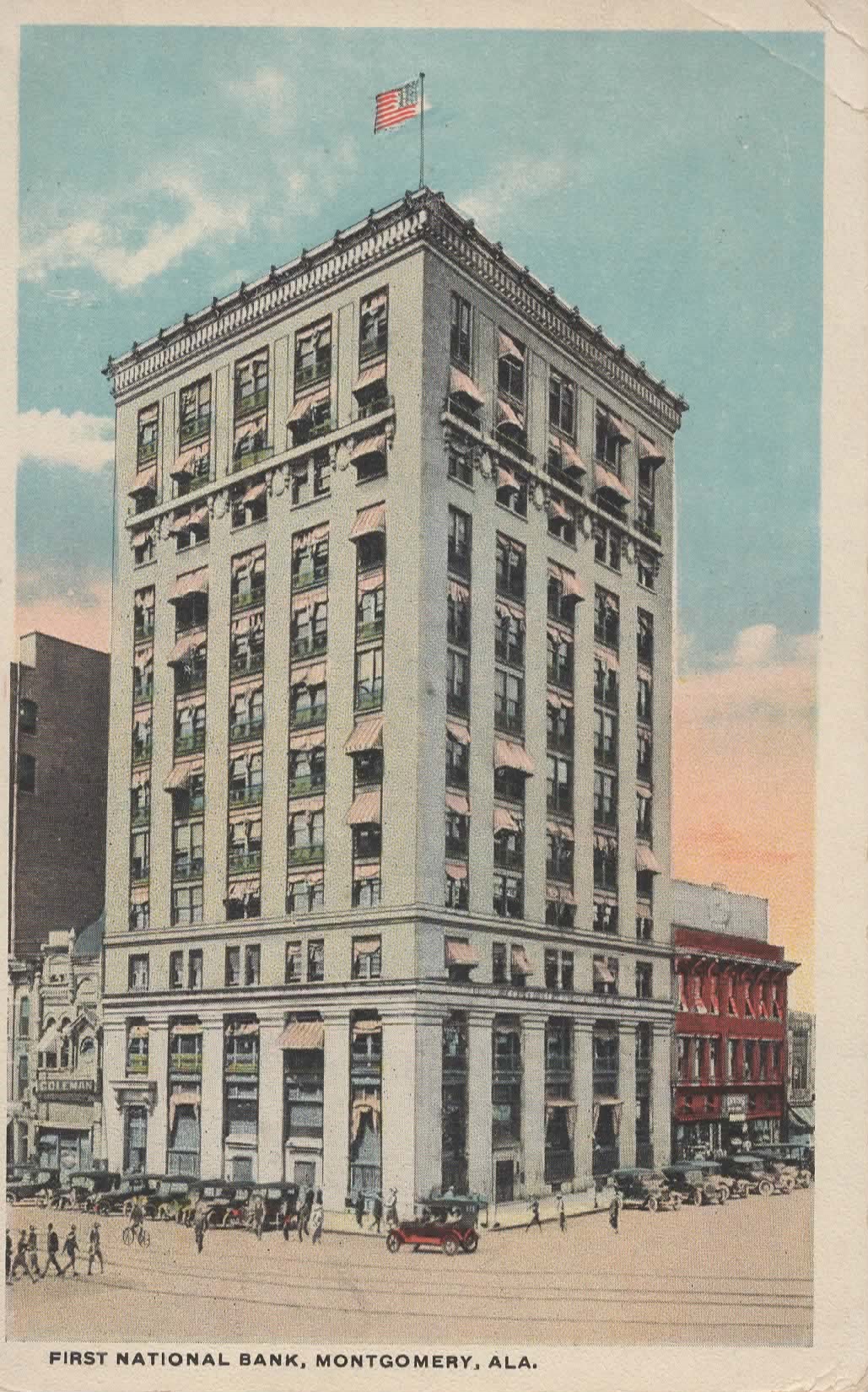
Photo Gallery
References
The Montgomery Advertiser. (October 31, 1889 p. 7). MOSES BROS. & CO. IN THEIR NEW OFFICES
Jewish World Review; Michael Feldberg. (retrieved January 6, 2022). Alfred Huger Moses, industrial visionary
The Montgomery Advertiser; Leopold Strauss. (October 24, 1931 p. 2). The Passing Of Illustrious Family Living Here Over 40 Years
The Montgomery Advertiser. (June 22, 1906). Bank Building and Moses Building. EXCHANGE OF PROPERTIES
The Montgomery Advertiser. (December 30, 1906). BIG MOSES BUILDING WILL BE RAZED AS SITE FOR STEEL SKYSCRAPER



